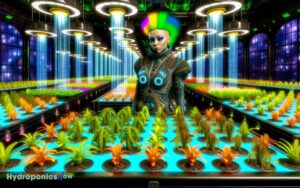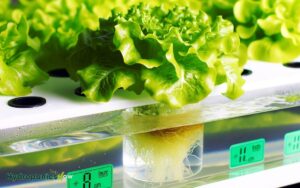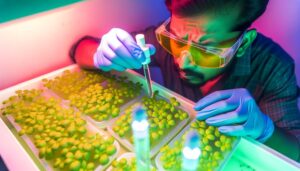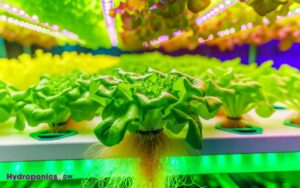Explain How You Start Hydroponic Seeds Then Plant Outside
Starting seeds hydroponically before transplanting them outdoors can optimize growth and plant health. Hydroponics provides accelerated growth, precise nutrient control, and reduced risk of soil-borne diseases.
To succeed, select adaptable seeds with high germination rates suited for both environments. Use full-spectrum LED lights, maintain ideal pH (5.5-6.5), and guarantee proper nutrient levels.
Gradually acclimate seedlings to natural conditions through hardening off, considering temperature and wind exposure. This controlled approach minimizes transplant shock and promotes robust outdoor growth.
Discover how meticulous preparation guarantees a smooth changeover and flourishing plants in the following sections.

Key Takeaways
Benefits of Hydroponic Seed Starting
Hydroponic seed starting offers numerous advantages, including accelerated growth rates, enhanced nutrient control, and reduced risk of soil-borne diseases.
By providing an optimized environment devoid of soil, hydroponic systems enable seedlings to absorb nutrients more efficiently, leading to faster development.
The precise control over nutrient composition and pH levels guarantees tailored nutritional support, optimizing physiological functions and promoting robust root and shoot growth.
Additionally, the absence of soil eliminates exposure to pathogens commonly found in traditional growing mediums, greatly reducing the incidence of diseases. This method also allows for better water utilization, minimizing waste and fostering a sustainable growing practice.
Choosing the Right Seeds
Selecting the appropriate seeds is paramount to maximizing the benefits of hydroponic seed starting and ensuring successful transplantation outdoors.
When choosing seeds, consider the following factors:
- Germination Rate: Opt for seeds with a high germination rate to increase the likelihood of robust seedling development.
- Adaptability: Select seeds that can thrive in both hydroponic conditions and the intended outdoor environment, ensuring a smooth progression.
- Growth Duration: Choose varieties that match your growing season length, accounting for both hydroponic and outdoor growth phases.
Additionally, prioritize seeds that are disease-resistant and suited to your local climate. This careful selection process will enhance plant health and productivity, ultimately leading to a more efficient and successful gardening experience.
Setting Up Your Hydroponic System
Setting up your hydroponic system necessitates a meticulous selection of suitable equipment, such as grow lights, pumps, and reservoirs, tailored to your specific plant requirements.
Equally critical is the precise preparation of a balanced nutrient solution, which involves calculating the best ratios of essential minerals to foster robust plant growth.
This section will explore these foundational aspects, ensuring your hydroponic setup is both efficient and effective.
Choosing Suitable Equipment
To establish an efficient hydroponic system, one must meticulously evaluate the various components required, including grow lights, nutrient delivery systems, and growing mediums, to guarantee peak plant health and growth.
Each component plays an essential role in creating an ideal environment for seedlings. Consider the following:
- Grow Lights: Choose full-spectrum LED lights to mimic natural sunlight, ensuring consistent light cycles for photosynthesis.
- Nutrient Delivery Systems: Opt for drip irrigation or nutrient film technique (NFT) systems to provide precise nutrient and water delivery.
- Growing Mediums: Select inert mediums like rock wool or coco coir, which offer excellent support and moisture retention without interfering with nutrient absorption.
Meticulous selection of these elements is vital for the successful progression of hydroponically grown seedlings to outdoor planting.
Nutrient Solution Preparation
Crafting a precise nutrient solution is fundamental to establishing a balanced hydroponic system, ensuring that plants receive the exact proportions of essential minerals for ideal growth and development.
Begin by selecting high-quality, hydroponic-specific nutrients, which typically include nitrogen, phosphorus, potassium, calcium, magnesium, and trace elements.
Use a calibrated pH meter to maintain the solution within an ideal pH range of 5.5 to 6.5, as nutrient uptake efficiency is pH-dependent.
Regularly monitor electrical conductivity (EC) levels to guarantee nutrient concentration remains within the recommended range for your plant species. Adjustments may be necessary as the plants grow and their nutrient requirements change.
Careful preparation and monitoring of the nutrient solution are essential for a successful hydroponic-to-outdoor shift.
Managing Light and Temperature
Effectively managing light and temperature is essential for the success of hydroponic systems and the smooth shift of plants to outdoor environments.
Ideal light levels must be meticulously calibrated to guarantee robust growth, while precise temperature regulation techniques are vital to maintain plant health and prevent stress.
Additionally, moving plants outdoors requires a gradual acclimatization process to mitigate shock and ensure continued development.
Optimal Light Levels
Achieving ideal light levels is crucial for hydroponic seed starting and outdoor planting as it directly influences photosynthesis rates, plant growth, and overall health.
The perfect light levels can be managed by considering several factors:
- Light Intensity: Hydroponic seedlings require a light intensity of 2000-3000 lumens per square foot. This guarantees sufficient energy for photosynthesis without causing stress.
- Light Duration: A photoperiod of 16-18 hours of light per day is recommended for most seedlings, mimicking long summer days to promote robust growth.
- Light Spectrum: Blue light (400-500 nm) supports vegetative growth, while red light (600-700 nm) encourages flowering and fruiting. Full-spectrum LED lights are ideal for providing balanced wavelengths.
Proper management of these parameters ensures a smooth shift from hydroponic systems to outdoor environments.
Temperature Regulation Techniques
Maintaining ideal temperature levels is important for the successful shift of hydroponic seedlings to outdoor planting, as temperature directly affects metabolic processes, enzymatic activities, and overall plant development.
To regulate temperature, it is essential to monitor both the ambient air and root zone temperatures. Utilizing heating mats can guarantee ideal root warmth, while shade cloths and ventilation systems help manage excessive heat.
Automated climate control systems can offer precision by adjusting conditions in real-time. Additionally, employing reflective surfaces can distribute light evenly, reducing hotspots.
Implementing these techniques can minimize thermal stress, thereby promoting strong growth and enhancing the adaptive capacity of seedlings when moving to outdoor environments.
Transitioning Plants Outdoors
Shifting hydroponic seedlings to outdoor environments necessitates a meticulous approach to managing light exposure and temperature fluctuations, guaranteeing the plants acclimate smoothly to their new conditions.
Gradual acclimatization is crucial for minimizing transplant shock.
Follow these steps to achieve the best results:
- Gradual Light Exposure: Begin by placing plants in shaded areas, incrementally increasing their exposure to direct sunlight over 7-10 days. This prevents sunburn and allows photosynthetic systems to adjust.
- Temperature Monitoring: Make sure that nighttime temperatures remain consistently above 50°F (10°C) to avoid cold stress. Utilize row covers or cloches for added protection during unexpected temperature drops.
- Wind Hardening: Expose seedlings to mild winds to strengthen their stems, reducing the likelihood of mechanical damage when permanently relocated outdoors.
Nutrient Solutions for Seedlings
Selecting the suitable nutrient solution for seedlings is crucial for guaranteeing the best possible growth and development in a hydroponic system. Seedlings require a balanced nutrient mix that promotes robust root development and healthy foliage.
Essential macro-nutrients such as nitrogen (N), phosphorus (P), and potassium (K) should be present in appropriate ratios, typically lower in concentration than for mature plants to prevent nutrient burn.
Additionally, micronutrients such as iron (Fe), calcium (Ca), and magnesium (Mg) are essential in trace amounts to support enzymatic functions and cellular processes.
The pH level of the nutrient solution should be carefully maintained, ideally between 5.5 and 6.5, to ensure nutrient availability and optimal uptake by the seedlings.
Monitoring Seedling Growth
Effective monitoring of seedling growth necessitates the use of precise metrics and regular observations to guarantee maximum development and early detection of potential issues.
This process involves scrutinizing several critical parameters to promote the health and vigor of the seedlings.
- Growth Rate: Measure the height and leaf count of seedlings regularly to track development and identify any stagnation.
- Nutrient Uptake: Monitor the electrical conductivity (EC) of the nutrient solution to maintain proper nutrient absorption and avoid deficiencies or toxicities.
- Root Health: Inspect root structures for signs of diseases, discoloration, or inadequate growth, as these can indicate underlying hydroponic system issues.
Detailed attention to these factors allows for timely interventions that can greatly enhance the chances of successful outdoor transplantation.
Preparing for Outdoor Transplant
Ensuring a successful outdoor transplant requires meticulous planning and execution of several critical steps to acclimate seedlings to their new environment.
Begin by selecting a suitable site that offers ideal sunlight, soil quality, and drainage. Conduct soil testing to determine pH levels and nutrient content, adjusting as necessary with amendments.
Prepare the soil by tilling to improve aeration and incorporate organic matter to enhance fertility. Create planting holes that match hydroponic growth mediums, ensuring minimal root disturbance during transfer.
Maintain consistent soil moisture levels to support root establishment. Additionally, monitor local weather forecasts to avoid transplanting during extreme conditions such as heavy rains or heatwaves.
This strategic preparation mitigates transplant shock and promotes robust plant development.
Hardening Off Seedlings
Hardening off seedlings is a critical process that involves gradually introducing young plants to the outdoor environment.
This process includes steps such as controlled exposure to natural sunlight to prevent shock, acclimatization to fluctuating temperatures to bolster resilience, and gradual wind exposure to enhance structural robustness.
Each of these elements is essential for ensuring successful transplantation and minimizing stress on the seedlings.
Gradual Light Exposure
Gradual light exposure, a critical phase known as hardening off seedlings, involves systematically acclimating the young plants to the outdoor environment to prevent transplant shock and promote robust growth.
This process helps seedlings adapt to the increased light intensity and UV radiation found outdoors, which can otherwise overwhelm them after being grown under controlled hydroponic conditions.
To guarantee successful acclimatization, follow these steps:
- Initial Exposure: Start by placing seedlings in a shaded outdoor area for 1-2 hours daily.
- Incremental Increase: Gradually increase exposure time by 1-2 hours each day, moving them to slightly sunnier spots.
- Full Sun Exposure: After 7-10 days, seedlings should be able to tolerate full sun for the entire day.
This methodical approach ensures seedlings develop resilience and thrive post-transplant.
Temperature Acclimatization Steps
In addition to light acclimatization, temperature acclimatization is a vital aspect of hardening off seedlings to prepare them for the fluctuating outdoor conditions.
This process involves gradually exposing hydroponically grown seedlings to outdoor temperatures over a period of 7-14 days.
Begin by placing seedlings outside for a few hours during the warmest part of the day, then gradually extend this period while introducing cooler morning and evening temperatures.
Maintain a close watch for signs of stress, such as leaf discoloration or wilting, adjusting exposure times as needed.
This gradual acclimatization enables seedlings to develop resilience, mitigating shock and ensuring robust growth when permanently transplanted. Monitoring and incremental adjustments are key for successful temperature acclimatization.
Wind Resistance Training
To effectively prepare hydroponically grown seedlings for outdoor conditions, it is imperative to incorporate wind resistance training into the hardening off process.
This technique strengthens the seedlings’ stems and acclimates them to the natural environmental stresses they will encounter.
The process involves gradually exposing the seedlings to gentle airflow, mimicking outdoor conditions.
- Initial Exposure: Place seedlings in a sheltered outdoor area for 1-2 hours, increasing exposure daily.
- Incremental Airflow: Use a fan on the lowest setting to simulate wind, gradually increasing the intensity over several days.
- Monitoring and Adjustment: Consistently monitor for signs of stress, such as wilting or leaf damage, and adjust exposure times accordingly.
Ideal Outdoor Planting Conditions
Ideal outdoor planting conditions are crucial for ensuring healthy plant growth and include factors such as soil composition, temperature, light exposure, and moisture levels. Soil should be well-draining, rich in organic matter, and have a balanced pH, typically between 6.0 and 7.0.
Temperature is essential; most plants thrive in a range of 60-75°F, avoiding extremes that can stress or damage seedlings. Adequate light exposure, ideally full sun for 6-8 hours daily, is important for photosynthesis and robust growth.
Moisture levels must be consistently monitored; soil should remain moist but not waterlogged, ensuring roots receive adequate oxygen while preventing root rot. Understanding these parameters helps create an ideal environment for moving hydroponically started seeds to outdoor growth.
Transplanting Techniques
Successfully transplanting hydroponically started seeds to an outdoor environment requires meticulous preparation and precise execution to minimize transplant shock and guarantee peak plant health.
The initial step is acclimatization, gradually exposing seedlings to outdoor conditions. This involves:
- Hardening Off: Gradually increase the seedlings’ exposure to sunlight and outdoor temperatures over 7-10 days.
- Root System Management: Ensure roots are gently untangled and retain some hydroponic medium to reduce root damage.
- Transplant Timing: Choose an overcast day or transplant during late afternoon to minimize stress from direct sunlight.
Implementing these steps with precision fosters healthy, resilient plants. Properly timed and managed, the shift from hydroponic systems to soil can be seamless, ensuring robust growth and development in an outdoor setting.
Post-Transplant Care
Consistently monitoring soil moisture levels and nutrient availability is critical for ensuring the successful establishment and growth of transplanted seedlings.
Adequate irrigation is paramount; newly transplanted seedlings require a balanced moisture environment to prevent both waterlogging and desiccation. Employing a soil moisture meter can provide precise readings to maintain ideal conditions.
Nutrient management is equally essential; moving from hydroponic to soil necessitates a gradual acclimation to soil-based nutrients. A balanced, slow-release fertilizer can help mitigate transplant shock by providing a steady nutrient supply.
Regular inspections for pest and disease presence are also vital, as seedlings are particularly vulnerable post-transplant. Utilizing organic mulches can assist in maintaining soil moisture and temperature, further promoting healthy root development.
Common Challenges and Solutions
While maintaining ideal post-transplant conditions is fundamental, growers often encounter a range of common challenges that can impede the successful establishment of seedlings.
These challenges include:
- Root Shock: Switching from a hydroponic system to soil can cause root shock, leading to stunted growth. Gradual acclimatization, known as ‘hardening off,’ can mitigate this risk.
- Nutrient Imbalance: Soil conditions may differ greatly from hydroponic environments, leading to nutrient deficiencies or toxicities. Regular soil testing and tailored fertilization can help maintain ideal nutrient levels.
- Pest Infestation: Seedlings grown hydroponically are often less exposed to pests. Upon moving outdoors, they may become more vulnerable. Implementing integrated pest management (IPM) strategies can effectively reduce pest-related issues.
Addressing these issues requires a methodical approach to ensure robust seedling development.
Conclusion
Starting seeds hydroponically before transplanting them outdoors offers numerous advantages, including optimized growth conditions, accelerated germination, and enhanced root development. Soaking seeds before hydroponics helps soften the seed coat, allowing for quicker and more uniform germination. This process ensures that seeds absorb adequate moisture before being placed in a hydroponic system, promoting strong and healthy seedlings. As a result, plants establish robust root structures, making the transition to outdoor growth smoother and more successful.
Choosing appropriate seeds, setting up an efficient hydroponic system, and managing light and temperature are critical steps. Additionally, providing the right nutrient solutions and ensuring ideal outdoor planting conditions are imperative.
Effective transplanting techniques and diligent post-transplant care further contribute to successful cultivation. Addressing common challenges with strategic solutions guarantees robust plant development and maximizes agricultural productivity.






